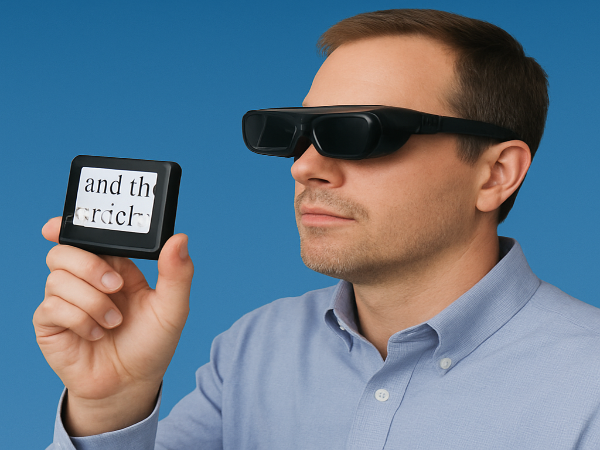Electronic Vision: Revolutionizing the Future of Sight Enhancement Technology
How Electronic Vision Devices Are Transforming Lives and Redefining Visual Accessibility

Electronic vision refers to advanced visual enhancement technology that integrates digital imaging, optical systems, and artificial intelligence to improve or restore sight for individuals with visual impairments. These devices—often called Electronic Vision Enhancement Systems (EVES)—use cameras, sensors, and displays to magnify, enhance, or reinterpret images, allowing users to perceive their surroundings more clearly. From wearable electronic glasses to stationary magnifiers, electronic vision technology is reshaping the future of visual accessibility, offering hope and independence to millions affected by low vision worldwide.
Introduction to Electronic Vision
The term electronic vision represents a significant leap in assistive and optical technology. It blends modern electronics, optical science, and artificial intelligence to create systems that can either enhance natural human vision or replace lost visual function. For decades, visually impaired individuals relied on optical magnifiers, telescopic lenses, and other mechanical aids. However, with rapid advancements in digital technology, the field of visual assistance has shifted toward electronic systems that provide clearer images, greater magnification, and enhanced flexibility.
Electronic vision devices are not just tools; they are lifelines for individuals struggling with visual impairments caused by conditions such as macular degeneration, glaucoma, diabetic retinopathy, and cataracts. These systems allow users to regain a sense of independence, enabling them to read, recognize faces, navigate environments, and perform daily tasks with improved confidence.
The Evolution of Electronic Vision
The journey toward electronic vision technology has been decades in the making. Early attempts at visual enhancement relied primarily on optical magnifiers and mechanical devices. The introduction of digital cameras, high-resolution displays, and compact electronics in the late 20th century revolutionized this field.
By the early 2000s, the concept of Electronic Vision Enhancement Systems (EVES) began gaining traction among researchers and medical professionals. These systems aimed to use digital imaging to compensate for deficiencies in the human eye. Instead of simply magnifying an image, they could adjust brightness, contrast, and color to make objects more visible to people with low vision.
The 2017 review by The College of Optometrists played a major role in classifying and understanding EVES. It highlighted how these devices could outperform traditional optical aids and outlined categories such as desktop magnifiers, portable systems, and wearable electronic glasses. Today, electronic vision continues to evolve with innovations in AI-driven image processing and augmented reality integration.
How Electronic Vision Works
Electronic vision devices function by capturing visual information through cameras or sensors and processing it to produce enhanced images on a display. These systems typically consist of three main components:
Input Unit (Camera or Sensor): Captures the real-world image in real time.
Processing Unit: Uses algorithms to adjust magnification, brightness, and contrast, and may also apply filters or recognition functions to enhance clarity.
Output Unit (Display): Projects the processed image to the user through a screen or head-mounted display, enabling real-time enhanced vision.
The technology can also include features like zoom control, edge detection, optical character recognition (OCR) for reading text aloud, and customizable contrast settings. Some advanced wearable devices integrate AI to automatically identify faces, objects, and text, providing auditory cues or visual overlays for the user.
Types of Electronic Vision Devices
Electronic vision systems can be broadly categorized into several types based on functionality and design. Each type serves a different purpose, catering to the unique needs of users.
Desktop Electronic Magnifiers
These are stationary devices equipped with large screens and powerful magnification capabilities. Users place printed materials under a camera, and the image is displayed on a screen with adjustable magnification and contrast. They are ideal for reading books, newspapers, or performing detailed work such as writing and crafting.
Portable Electronic Magnifiers
Handheld magnifiers offer flexibility and portability. They use small screens and rechargeable batteries, allowing users to read menus, labels, or documents anywhere. Despite their compact size, many feature autofocus, adjustable color modes, and freeze-frame options.
Wearable Electronic Glasses
Perhaps the most advanced form of electronic vision, wearable glasses combine cameras and displays within a headset or eyeglass frame. These systems, such as eSight and IrisVision, provide a real-time enhanced visual experience. Users can see distant and close-up objects by simply adjusting digital zoom or focus settings. Many models now use augmented reality and AI-based object recognition.
Smartphone-Based Systems
Modern smartphones have become powerful tools for visual enhancement. Apps use the phone’s camera to magnify text or images, apply filters, and even read text aloud. This accessibility makes electronic vision technology more affordable and widespread.
Implantable and Neuromorphic Devices
Researchers are developing implantable devices that stimulate the retina or visual cortex directly. These devices, though experimental, hold promise for restoring partial vision to individuals with complete blindness. Neuromorphic technology mimics the human brain’s visual processing to achieve more natural and adaptive image enhancement.
Applications of Electronic Vision Technology
The uses of electronic vision extend far beyond simple magnification. Here are some of the key applications:
Reading and Writing: Enables individuals with low vision to read books, bills, and computer screens comfortably.
Navigation: Helps users move safely through unfamiliar environments using enhanced vision and object detection.
Education: Supports visually impaired students by allowing them to view classroom materials, whiteboards, and digital screens clearly.
Workplace Accessibility: Assists professionals in performing tasks that require detailed visual observation.
Healthcare: Used by doctors and optometrists for vision training and rehabilitation exercises.
Electronic vision technology is also being integrated into robotics, autonomous vehicles, and AI systems to simulate human-like vision, making it a cornerstone of future innovation.
Advantages of Electronic Vision Systems
The rise of electronic vision technology offers numerous benefits compared to traditional optical aids:
Enhanced Image Clarity: Digital processing eliminates optical distortions and improves overall image quality.
Adjustable Settings: Users can customize magnification, brightness, and contrast based on personal comfort.
Comfortable Viewing Distance: Allows users to maintain a natural posture while reading or observing objects.
Multiple Viewing Modes: Supports various color combinations and contrast modes for different visual conditions.
Binocular Viewing: Many devices allow both eyes to work together, creating a more natural visual experience.
Portability and Versatility: Portable and wearable models make visual enhancement possible anywhere.
Integration with AI: Future-ready models incorporate facial recognition, text reading, and object identification.
Challenges and Limitations
Despite its promise, electronic vision technology faces several challenges that must be addressed to achieve mainstream adoption:
High Cost: Advanced EVES devices can be expensive, limiting access for many users.
Battery Life: Wearable devices require frequent charging, which can hinder usability.
Complexity of Use: Some devices have steep learning curves for elderly users or those unfamiliar with technology.
Limited Field of View: High magnification often reduces the area visible on the screen, making navigation difficult.
Aesthetic Concerns: Bulky or noticeable devices can make users self-conscious in social settings.
Researchers are working to overcome these barriers by creating lightweight, affordable, and user-friendly designs powered by AI and cloud-based processing.
The Role of Artificial Intelligence in Electronic Vision
Artificial intelligence (AI) is rapidly transforming the field of electronic vision. Machine learning algorithms enable devices to recognize faces, detect objects, read text, and even interpret emotions. This level of intelligence allows visually impaired individuals to navigate more confidently and understand their environment beyond what traditional magnification can offer.
AI-based systems can also adapt to user behavior, automatically adjusting brightness or zoom based on the task being performed. The combination of AI and wearable vision technology marks the beginning of a new era in assistive devices, bridging the gap between human perception and machine learning.
Future of Electronic Vision
The future of electronic vision looks incredibly promising. Continuous innovations in display technology, artificial intelligence, and biomedical engineering are paving the way for more sophisticated, affordable, and user-friendly solutions.
Emerging trends include:
Augmented Reality (AR) Integration: Combining real-world visuals with digital overlays for enhanced situational awareness.
Miniaturized Wearable Devices: Sleeker, lighter designs that resemble ordinary glasses.
Cloud Connectivity: Devices that store user preferences and adapt across different environments.
Brain-Computer Interfaces: Direct communication between visual prosthetics and the brain to restore sight in cases of total blindness.
As technology advances, electronic vision could evolve beyond assistive applications and become a tool for everyone—enhancing human performance in industries like surgery, aviation, and design.
Conclusion
Electronic vision is not just a technological innovation—it’s a movement toward inclusivity, empowerment, and human potential. By merging optics, electronics, and artificial intelligence, these systems restore hope and independence to individuals with visual impairments. As research and innovation continue, the boundaries between human and machine vision will blur, ushering in a new age of clarity and accessibility for all.
From reading a book to recognizing a loved one’s face, electronic vision devices are transforming lives—proving that the future of sight is not just about seeing, but about experiencing the world with renewed vision and confidence.



